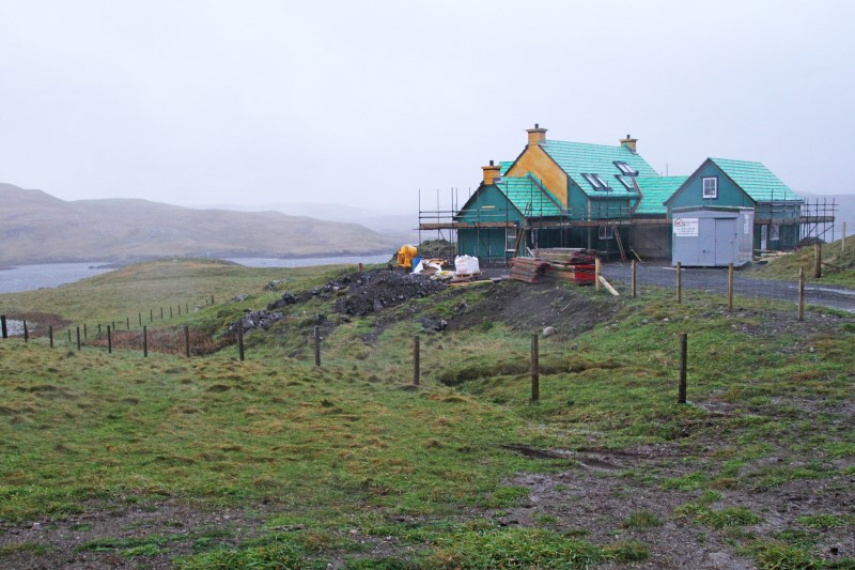
Rural Housing
David Stewart
As we publish the next report in our Review of Land for Housing and Development, Scottish Land Commission Senior Policy Officer David Stewart discusses how the houses that rural Scotland needs can be delivered.
The large housebuilders who deliver most of Scotland’s new homes are not active in rural Scotland. This is unlikely to change; their business model relies on a rate of return that they cannot achieve in most rural areas. This means that new models of delivery need to be developed and other housing providers supported to deliver the homes that rural Scotland needs.
This stark finding comes from a new report published today, looking at how to improve the provision of housing in rural Scotland. It is part of a review into land for housing and development being undertaken by the Commission. This will examine the way that land is delivered for housing and how this can be changed to create places people want to live at prices they can afford.
Previously, work investigating the Scale and Concentration of Land Ownership found that some communities believed that a lack of access to land was limiting the development of rural housing. The concern was that, where one landowner controls land in an area, it may not be possible to access suitable land at a reasonable price to build housing that the community needs.
This study was commissioned, in part, to investigate this issue further. We also wanted to identify approaches to rural housing development that work and can be repeated. Finally, the Commission sought ideas on how to deliver more homes and better places.
Savills were appointed to conduct the study because of their expertise in rural planning, land deals and development economics. The study involved a review of relevant research, interviews with key players and two stakeholder workshops.
Below, Graham Reid and Debbie Mackay of Savills set out the main findings from the study.
Key Challenges
Graham:
“Perhaps the main challenge is the complexity of delivering housing in rural Scotland. A wide range of factors can enable or frustrate rural housing delivery. With housebuilders not active in rural areas, other bodies, often not for profit, are left to fill the gap and deliver these complex projects.”
In Savills’ view, the impact of a lack of access to land may be overstated, with land just one of many pieces in a complex jigsaw puzzle. They point to the benefits of improved communication and collaborative working to break down perceived barriers. The Commission recognises, however, that there will be cases where an inability to access land prevents the development of homes. Although the number of such cases may be relatively small, it is important that there are mechanisms in place that can be used to address such situations when they do arise. We are working on a public interest test on land ownership, and on a land rights and responsibilities review that could help to do this.
Good Practice and Collaboration
The other major finding from the study was the amount of good work that is already going on.
Graham notes:
“There are some great examples of collaboration and the adoption of innovative models that have the potential to be replicated and scaled up to help unlock land opportunities. We have been hugely impressed by the ingenuity, creativity and good practice that we have uncovered.”
Outputs and Resources
Three of the main outputs from the research are a chapter setting out practical ways to address the key land challenges, a toolkit highlighting currently available support and setting out different approaches to unlocking development, and five illustrative case studies. These are valuable resources for anyone looking to develop rural housing.
The report sets out six recommendations to deliver more rural homes and create better places:
- Increased expert support to help deliver rural housing projects
- More participation in housing development by a broader range of stakeholders
- The creation of a stable and long-term funding regime
- Increased transparency around land sales values in order to help pricing negotiations
- Simplification of the technical approval process
- The development and roll out of a rural training package for local planning authorities.
Key Findings and Next Steps
The report highlighted ways which, in the short term, barriers to rural housing development could be reduced. Development can be inhibited either because there is a presumption against new rural housing, or because planning and development policy is not sympathetic to rural circumstances.
Debbie explains:
“Councils with rural areas should have rural development and planning policies to reflect the different needs and challenges in rural Scotland. They need to avoid using approaches designed for urban Scotland which could prevent rural areas from reaching their potential.”
Local Authorities need to avoid burdening rural developments with requirements designed for urban areas.
This would help by acknowledging the need for appropriate scale development to support rural communities. It would also avoid burdening rural developments with requirements designed for urban areas.
The research identified that Housing Need and Demand Assessments – which councils undertake to establish housing need in their area – are not suited to identifying the more localised needs of rural areas with small and scattered populations. Local surveys (such as those carried out by support organisations such as the Development Trusts and Rural Housing Scotland) can identify need at a more granular level. This approach should be expanded where communities highlight a need for affordable housing.
In the medium term, the new Planning Act provides significant opportunities to help rural communities flourish. Local Development Plans should be based on early community engagement, while Local Place Plans could enable the creation of well-planned, attractive places with enough homes to meet local need. The need and demand surveys highlighted above could inform the Local Place Plan.
The Applecross Case Study provides an example of how Local Place Plans might work. Local people identified a need for affordable housing and employment opportunities in one of the most remote communities in Scotland. Working with the local landowner and other partners, a Community Land Use Plan was developed to “promote affordable development land for housing, employment and community uses for local residents and those wishing to make a long-term contribution to the Applecross community”.
Capacity and Expertise
Developing homes in rural Scotland is challenging and these complex projects are often community led. There is a need for expert support to reduce risk and make land development ready. The report identifies that the support bodies identified above provide a valuable service and calls for an expansion of this ‘facilitation’ role.
The authors suggest that one approach would be to set up a national agency to provide expertise to all stakeholders to make land development ready. This idea is one of the questions being considered by the Infrastructure Commission at the moment and we look forward to finding out what they think about it over the next few weeks.
As far as rural housing goes, our conclusion is that, while there is a need for further support, exactly how this should be delivered needs careful consideration to avoid adding more layers of complexity. Our initial thinking is that a potential approach would be to build on or replicate existing models. Successful examples of assistance exist through the support bodies and models such as the Highland Housing Hub. There is a case to increase the capacity of existing providers and to replicate successful models elsewhere, making adaptations to fit local circumstances.
Longer Term Change – A Greater Role for the Public Sector
The study identified two major challenges with rural housing development. Firstly, the private housebuilder model does not work for most of rural Scotland. Secondly, not-for-profit organisations are often required to fill this gap if housing is to be delivered, undertaking complex and risky projects.
One solution if for smaller local housebuilders to deliver more homes in rural areas. A range of tools and solutions to support this are set out in chapters 7 and 8 of the report.
Longer term, if homes are to be developed to meet rural Scotland’s needs, then there is a case for the public sector to play an active role in initiating and shaping development, making land ready for new housing. The Commission plans to develop thinking on how this could be achieved, working closely with local authorities and other partners.
Further Information
The Role of Land in Enabling New Housing Supply in Rural Scotland
The Role of Land in Enabling New Housing Supply in Rural Scotland - Toolkit
Case Studies
Planning Skills Webinar – Land, Planning & Delivering Rural Affordable Housing
